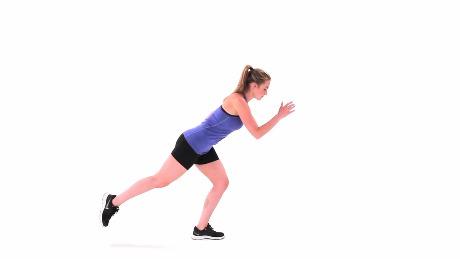Written by Dr. Nicholas Parton, DPT, MTC, CSCS

Spending your time divided between three sports with three different postures and range of motion demands leads to different things for different people. For some, injury risk reduction is achieved because each sport provides a balance between muscles, such as swimming providing your legs with counter-balance and core strength – sort of like the old running mantra “strong arms carry tired legs.” However, each sport in triathlon occurs primarily in one plane, straight forward motion. This has the potential to be a problem if an athlete’s muscles become exceptionally powerful and efficient in straight forward motion, but lose balance in lateral control musculature and stabilizing musculature compared to the primary movers. Thus it is important to include some full body strength and balance. Most athletes know that core is an important addition to our training regimen as it can reduce the stress on the body and make us more efficient and stable in extremity movements. Additionally, balance and stability training as well as rotational and lateral control activities can be important additions to your training regimen. Including these activities in your strength program two to three times per week can help reduce the stress that can accumulate with the repetitive single plane motions of the sports in which we participate.
Running is the most jarring of the triathlon sports and the force from landing combined with the muscular fatigue of performing the swim and bike first require you to have a certain degree of strength and flexibility to avoid overstressing your musculoskeletal system and ending up in a physical therapy office. So let us try to prehab you away from a physical therapy office and into continued healthy running. Let’s test out and try the exercises below, which I divided into three different common problem areas, to determine what could be beneficial to keep you on the road and trails. If running isn’t your favorite of the three sports, maybe these could help out as well.
Some things to focus on and think about during these exercises:
Can you do the motions under control?
Do not advance the basic exercises and recruitment exercises until you can perform the baseline exercises with consistent muscular control.
Are you rocking or rolling and recruiting other movements to complete the exercise?
If so, you are not ready for that exercise and need to focus on the recruitment pattern with the preliminary exercises. When you undertake any new exercises, especially ones with multiple movements, the first thing you should focus on is if you are performing the range of motion properly while recruiting the correct muscle pattern. If you are not recruiting the muscles appropriately and cannot perform the basic single exercises properly, you will not be helping yourself by moving to more advanced exercises that require proper control to be performed in a healthy manner.
Are you having trouble with certain aspects of an exercise?
Break it down. For example, if you can’t do a single leg squat because you lose balance, perform that piece of the exercise separately. Start with single leg balance while you brush your teeth every morning and night. Then balance on a pillow with one leg, followed by balancing on a pillow with one leg while reaching left and right. This will in turn assist you to keep your balance during future high-level exercise. Do you find you can’t get up from a single leg squat? Try a wall sit and alternate kicking one leg out straight in front of you. There are many options to break down advanced exercises into pieces which will allow you to put it all together in the future. Creativity will be rewarded!
Area 1 : Core and Gluteal Stability and Basic Strengthening

Exercise 1:1 Gluteal Bridge
How it’s done: Lay down on your back with your feet underneath bent knees. Drive through your heels by squeezing your buttocks to raise your buttocks off of the ground until your weight is shared between your shoulder blades and heels.
How to Advance it: Try it single legged! Keep your pelvis level, kick one foot out straight and rep it out on the planted leg. Then reverse.
Exercise 1:2 Bird Dogs
How it’s Done: Start on all fours. To get your balance you may begin by extending one arm or one leg straight while maintaining a neutral spine. Pull your belly button into your spine and keep breathing. When ready, raise one arm and the opposite leg into the air. Keep a strong neutral spine and engage the shoulder blade and buttock muscles. Alternate this diagonal lift pattern back and forth 20 times.

Exercise 1:3 Forearm Plank and Side Plank
How it’s Done: Form! Form! Form! Your butt belongs in line with your body and your belly button should be pulled inward towards your spine engaging your deep core muscles. Avoid dropping your pelvis or raising it up into the air. Engage all of your muscles from your chest through your abs down into your quads. Keep breathing at a steady pace and count 10+ breaths. Give each angle a break by rotating between forward, sideways, and reverse planks as you try to increase your total time planking each week or two.
How to Advance it: First off, you could add the other fantastic similar exercise of pushups. For the forearm plank, try tapping each foot out to the side in a slow controlled motion while maintaining your breath and rigid core and back. If that’s too easy, move to one arm raises in front. For the side plank, try using a weight in the free arm and performing arm raises, if that is too easy, try side leg raises with the upper leg or combine leg and arm raises.
Area 2: Hip Rotation and Lateral Stability

Exercise 2:1 Fire Hydrants (Hip Abduction and External Rotation)
How it’s Done: Start on hands and knees in quadruped. Raise one leg out directly to the side opening up the hips. Focus on squeezing the outer part of your buttocks. Start with 10 reps as long as you can keep good form and control. We want quality over quantity.
How to Advance it: Once into the finishing position, kick your leg out straight to the side in a slow controlled motion, bring it back to the original finishing position, then down towards the mat without letting your knee touch, kick straight backwards into a donkey kick, bring back under your belly, then back out the side completing the cycle. Stay controlled and roll through without resting that leg for 10 reps.

Exercise 2:2 Clamshells to Monster Walks
How it’s Done: Clamshells (left picture) are another bread and butter activation exercise. The effort comes from the outer part of your buttocks or outer hip/pelvic region. Keep feet touching and open up from closed to open knees to perform the exercise. You should be able to perform this in a controlled and stable manner which will assure that you can recruit these muscles properly during dynamic standing exercise. Work up to two sets of 20 reps.

How to Advance it: Monster or Band Walks (right picture) are a functional way to advance clamshells and fire hydrants into standing. With a band around your ankles step outwards to create tension. Keep a wide stance and tension through the band. Walk forwards with a diagonal outward force trying to pull your feet inwards each step, do not let it pull you in! Go up and down a hallway 10 times.

Exercise 2:3 Diagonal Reach – Single Leg Deadlift Balance
How it’s Done: Place two objects on the floor equidistance apart, about 2 feet works well, and stand 2 feet behind the objects. In a slow controlled fashion, reach with the arm opposite the object you will touch down and forward towards the object while bending forward with a neutral spine and lifting the same side leg. Control your descent with your planted leg and strong core posture. Do not let your leg/hip fall out to the side. E.g. reach towards the object on your right with your left arm while lifting your left leg straight behind you. Repeat on each side back and forth 10 times in a controlled fashion.

Area 3: Ankle Stability and Balance

Exercise 3:1 Runner’s Single Leg Balance
How it’s Done: This exercise goes through the balance on the striking leg. Do not leg your balancing leg collapse inward nor planted leg’s knee bend in further forward than your toes. Choose a starting leg and attain upright posture. March the leg to 90 degrees in front, then slowly lean forward and extend the leg without touching it down to the ground. Focus on control and balance with a slow and smooth motion. Repeat 5 times on each leg and 2 times through.

Exercise 3:2 Single Leg Balance on an Unsteady Surface
How it’s Done: Use a pillow, balance disc, or foam pad on the floor. Perform in a safe area of the home where you can prevent a fall if necessary. Step onto the surface, then lift one leg in order to balance on the other. Hold for 10 seconds to start and work upwards to a minute. Once you can perform for a minute on each leg, begin reaching up/down and left/right with your arms to increase dynamic ankle stability and balance.

Exercise 3:3 Single Leg Hops in Square and Diagonal Pattern
How it’s Done: Place a cross on the floor with tape or rope. Choose a leg to begin and perform controlled hops in clockwise, counter clockwise, and diagonals between the outer squares. Repeat each 10 times on each leg.
 About the Author: Dr. Nicholas Parton, DPT, MTC, CSCS is a Doctor of Physical Therapy with Manual Therapy Certification and Certified Strength and Conditioning Specialist in Colorado Springs. He works with athletes in their homes and in the field through Parton Physical Therapy (www.partonpt.com), spends his free time triathlon training with the support of TriSports.com, and enjoys getting lost in the mountains with his wife, Jessica.
About the Author: Dr. Nicholas Parton, DPT, MTC, CSCS is a Doctor of Physical Therapy with Manual Therapy Certification and Certified Strength and Conditioning Specialist in Colorado Springs. He works with athletes in their homes and in the field through Parton Physical Therapy (www.partonpt.com), spends his free time triathlon training with the support of TriSports.com, and enjoys getting lost in the mountains with his wife, Jessica.
Disclaimer: Exercise is not without its risks and this or any other exercise program may result in injury and/or death. Any person who undertakes these exercises does so at their own risk. To reduce the risk of injury you should consult your doctor before beginning this or any other exercise program. As with any exercise program, if at any point during your workout you believe conditions to be unsafe or begin to feel faint or dizzy, have physical discomfort, or pain, you should stop immediately and consult a physician. It is important to perform exercises properly to avoid injury, it is recommended that you acquire help and teaching in order to undergo any new exercise program safely. Exercise at your own risk.This is a Home Exercise Program that may be appropriate for most runners. Certain exercises may not be safe for you to perform based on health conditions. Home Exercise Program images utilized from Home Exercise Builder on Medbridge Education™
